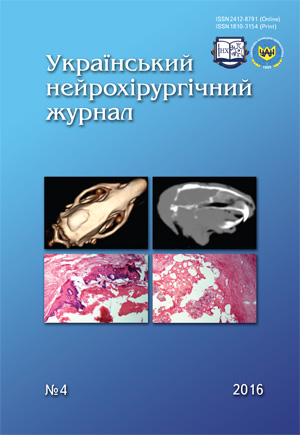Analysis of the effectiveness of delayed cranioplasty of skull defects using nanocomposite metalloceramic in the experiment
DOI:
https://doi.org/10.25305/unj.86582Keywords:
delayed cranioplastic, large flap craniotomy, nanocomposite metal ceramic, nanocomposite bioceramic cementAbstract
Objective. To substantiate the use of the nanocomposite metal ceramics for the delayed cranioplasty in rats in the experiment based on the analysis of the results of spiral computed tomography and morphological investigations.
Materials and methods. In the experiment, a delayed cranioplasty with the use of nanocomposite metal ceramics was performed in 10 white rats (body weight 300–450 g, average age 6–8 months old).
Results. SCT data showed an absolute consolidation of used grafts with bone defect. The nanocomposite metal ceramic implant showed a high effectiveness for replacement of the bone defects and for the forming of the regenerate with the active participation of the surrounding tissues, especially blood vessels invasion into the implant.
Conclusions. 1. The experiments results confirmed the possibility of large-flap craniotomy with the following delayed cranioplasty in rat bucks using nanocomposite metal ceramic.
2. The use of the nanocomposite metal ceramic promotes to formation of newly formed bone tissue either dense or spongy one.
3. The use of nanocomposite metal ceramic may be recommended for clinical trials.
References
Hobzey NК, Pedachenko YeG, Golyk VA, Guk AP, Gondulenko NА. Epidemiologiya invalidnosti vsledstviye cherepno-mozgovykh travm v Ukraine [Disability due to traumatic brain injury epidemiology in Ukraine]. Ukrayina. Zdorovya Natsiyi. 2011;(3):30-4. Russin. Available at: http://nbuv.gov.ua/UJRN/Uzn_2011_3_7
Glumcher FS, Fomin PD, Pedachenko YeG. Politravma. Khirurgiya, travmatologiya, anesteziologiya, intensivnaya terapiya: uchebn. izdaniye [Polytrauma. Surgery, traumatology, anesthesiology, intensive care]. Kiev: Meditsyna; 2012. Russin.
Greenberg, MS. Handbook of Neurosurgery. New York: Thieme Medical Publishiers; 2010.
Bonfield CM, Kumar AR, Gerszten PC. The history of military cranioplasty. Neurosurg Focus. 2014 Apr;36(4):E18. [CrossRef] [PubMed]
Polishchuk M, Danchin A, Goncharuk O. [Treatment strategy at combat traumatic brain injury]. Ukrainian Neurosurgical Journal. 2016;(1):31-9. Ukrainian. [Abstract/Full Text].
Aydin S, Kucukyuruk B, Abuzayed B, Aydin S, Sanus GZ. Cranioplasty: Review of materials and techniques. J Neurosci Rural Pract. 2011;2(2):162-7. [CrossRef] [PubMed]
Dubok VA. Bioceramics―Yesterday, Today, Tomorrow. Powder Metallurgy and Metal Ceramics. 2000;39(7-8):381-94. [CrossRef]
Sarkisov DS, Perov YL. Mikroskopicheskaya tekhnika. Rukovodstvo dlya vrachey i laborantov [The microscopic technique. Guide for physicians and laboratory technicians]. Moscow: Meditsyna; 1996. Russin.
Dedukh NV, Dursunov AM, Malyshkina SV. Regeneratsiya kostnogo defekta pri vvedenii zhivotnym preparata osteogenon [Regeneration of bone defects in animals after applying of the drug osteogenon]. Orthopaedics, Traumatology and Prosthetics. 2004;(2):40-5. Russin.
Malyshkina S, Dedukh N. Medyko-biolohichni doslidzhennya shtuchnykh biomaterialiv dlya ortopediyi ta travmatolohiyi [Medical-biological studies of artificial biomaterials for orthopaedics and traumatology]. Orthopaedics, Traumatology and Prosthetics. 2010;(2):93-100. Ukrainian. [CrossRef]
Downloads
Published
How to Cite
Issue
Section
License
Copyright (c) 2016 Vadym Biloshytsky, Alexander Nakhaba, Anna Shmeleva, Oleg Robak, Vitalii Dubok

This work is licensed under a Creative Commons Attribution 4.0 International License.
Ukrainian Neurosurgical Journal abides by the CREATIVE COMMONS copyright rights and permissions for open access journals.
Authors, who are published in this Journal, agree to the following conditions:
1. The authors reserve the right to authorship of the work and pass the first publication right of this work to the Journal under the terms of Creative Commons Attribution License, which allows others to freely distribute the published research with the obligatory reference to the authors of the original work and the first publication of the work in this Journal.
2. The authors have the right to conclude separate supplement agreements that relate to non-exclusive work distribution in the form of which it has been published by the Journal (for example, to upload the work to the online storage of the Journal or publish it as part of a monograph), provided that the reference to the first publication of the work in this Journal is included.









